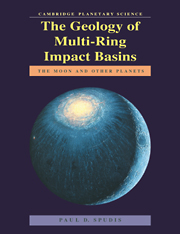Book contents
- Frontmatter
- Contents
- Preface
- 1 The multi-ring basin problem
- 2 From crater to basin
- 3 The ‘archetype’ basin: Orientale
- 4 An ancient basin: Nectaris
- 5 A modified basin: Crisium
- 6 A transitional basin: Serenitatis
- 7 The largest basin: Imbrium
- 8 Geological processes in the formation of lunar basins
- 9 Multi-ring basins on the terrestrial planets
- 10 Multi-ring basins and planetary evolution
- References
- Index
4 - An ancient basin: Nectaris
Published online by Cambridge University Press: 12 October 2009
- Frontmatter
- Contents
- Preface
- 1 The multi-ring basin problem
- 2 From crater to basin
- 3 The ‘archetype’ basin: Orientale
- 4 An ancient basin: Nectaris
- 5 A modified basin: Crisium
- 6 A transitional basin: Serenitatis
- 7 The largest basin: Imbrium
- 8 Geological processes in the formation of lunar basins
- 9 Multi-ring basins on the terrestrial planets
- 10 Multi-ring basins and planetary evolution
- References
- Index
Summary
The Nectaris basin is located on the lunar near side (Figure 1.1), south of Mare Tranquillitatis and west of Mare Fecunditatis. An origin by impact for the Nectaris basin was advocated first by Baldwin (1949, 1963), who paid particular attention to the development of the Altai scarp, the southwestern topographic rim of the basin (Figure 4.1). The basin is relatively well preserved and served as a prototype multi-ring basin in the pioneering study of Hartmann and Kuiper (1962). More recent systematic studies of the Nectaris basin are those of Whitford-Stark (1981b), Wilhelms (1987), and Spudis et al., (1989). The Apollo 16 mission to the Descartes highlands in 1972 collected samples and orbital data that are directly applicable to comprehension of Nectaris regional geology. In this chapter, I describe the geology of the Nectaris basin and synthesize various data into a geological model for its origin and subsequent development.
Regional geology and setting
The Nectaris basin formed in typical crust of the near side highlands and interacted with two older basins. The average thickness of the crust in the region is about 70 km (Bills and Ferrari, 1976). The surrounding terrain consists of heavily cratered highlands, except where buried by later mare basalts. Nectaris deposits are well preserved to the south and west of the basin, but have been buried to the north and east by the lavas of Maria Tranquillitatis and Fecunditatis (Figure 4.1).
- Type
- Chapter
- Information
- The Geology of Multi-Ring Impact BasinsThe Moon and Other Planets, pp. 67 - 88Publisher: Cambridge University PressPrint publication year: 1993

